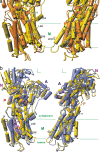How processing of aspartylphosphate is coupled to lumenal gating of the ion pathway in the calcium pump
- PMID: 18077416
- PMCID: PMC2148383
- DOI: 10.1073/pnas.0709978104
How processing of aspartylphosphate is coupled to lumenal gating of the ion pathway in the calcium pump
Abstract
Ca(2+)-ATPase of skeletal muscle sarcoplasmic reticulum is the best-studied member of the P-type or E1/E2 type ion transporting ATPases. It has been crystallized in seven different states that cover nearly the entire reaction cycle. Here we describe the structure of this ATPase complexed with phosphate analogs BeF(3)(-) and AlF(4)(-) in the absence of Ca(2+), which correspond to the E2P ground state and E2 approximately P transition state, respectively. The luminal gate is open with BeF(3)(-) and closed with AlF(4)(-). These and the E1 approximately P.ADP analog crystal structures show that a two-step rotation of the cytoplasmic A-domain opens and closes the luminal gate through the movements of the M1-M4 transmembrane helices. There are several conformational switches coupled to the rotation, and the one in the cytoplasmic part of M2 has critical importance. In the second step of rotation, positioning of one water molecule couples the hydrolysis of aspartylphosphate to closing of the gate.
Conflict of interest statement
The authors declare no conflict of interest.
Figures







References
-
- MacLennan DH, Brandl CJ, Korczak B, Green NM. Nature. 1985;316:696–700. - PubMed
-
- de Meis L, Vianna AL. Annu Rev Biochem. 1979;48:275–292. - PubMed
-
- Albers RW. Annu Rev Biochem. 1967;36:727–756. - PubMed
-
- Post RL, Hegyvary C, Kume S. J Biol Chem. 1972;247:6530–6540. - PubMed
-
- Toyoshima C, Nakasako M, Nomura H, Ogawa H. Nature. 2000;405:647–655. - PubMed
Publication types
MeSH terms
Substances
Associated data
- Actions
- Actions
- Actions
- Actions
LinkOut - more resources
Full Text Sources
Miscellaneous

